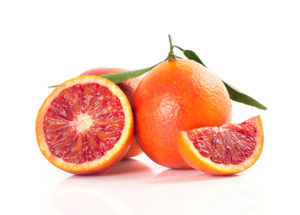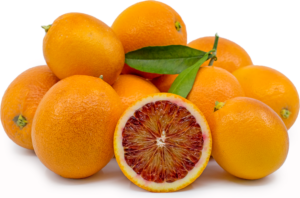BLOOD ORANGES

TODAY’S LESSON: Winter salads are rich while being refreshing. Leafy greens that grow during these cool temperatures are low in carbs while delivering some protein and fiber to your diet. Today we will add the winter greens to the king of citrus, the blood orange, for a salad to long winter for.
WHAT EXACTLY IS A BLOOD ORANGE AND WHERE DOES IT COME FROM? A blood orange is produced by just a few varieties of the orange family. It is thought to have originated in China and been cultivated in Europe, specifically Italy and Spain, as well as Northern Africa in Algeria, Morocco, and Tunisia. They have been grafted onto existing rootstock in California and have increased in volume every year. This orange is called a blood orange for the intense maroon color and deep almost raspberry scented flavor.
WHAT ARE THE VARIETIES? The most important varieties of blood oranges are:

* “Moro” is one of the favorites and the largest in production coming out of California into your supermarkets. It originates from the Sanguinello Moscato variety grown extensively in Italy. The fruit is deep maroon in color, round to oval in shape and varies in skin color from pure orange to deep red blush. They are juicy with higher acid flavor in December falling to the rich fruit flavor by February. They are usually seedless but a few seeds show up now and then.

* “Tarocco” is the largest produced variety grown in Italy but with a wider variation in flesh color from the red blushed-orange to deeper red with more like strawberry flavor tones. They are sweet with a high acid content in perfect balance for a terrific flavor.

* “Sanguinelli” is the largest variety produced in Spain with a red exterior and streaked pale red interior on maturity with more like strawberry to pineapple flavor tones. It is very juicy, sweet with low acid and few if any seeds.
WHY DO THEY TASTE SO GOOD? Blood oranges are generally lower in acid than their orange-fleshed cousins. These flavors taste more red and softer than orange thus the different blood oranges are compared more towards the red fruit of raspberries and strawberries.
ADVANTAGES: Like other citrus fruit they are high in Vitamin C, low in sodium and about 65 calories per fruit.
CHOOSE YOUR BLOOD: Select your blood oranges by the heavier weight and fragrant smell, avoiding bruised or flattened fruit. They are best as fresh as possible and may be stored for a few days in your refrigerator. They are more delicate than standard orange varieties so treat them with care, especially since they are a little more expensive.
We have been buying Moro blood oranges that have a little sticker on them that says; Sunkist(TM) Moro #4381. These are the most readily available in the market so far this year.
TRY YOUR TECHNIQUE: Combine the best of the season’s bounty with CRAB, BLOOD ORANGE, AND ENDIVE SALAD.
LUMP CRAB, BLOOD ORANGE, AND ENDIVE SALAD
Makes 4 servings of about 12 grams carbohydrates,
25 grams protein and 4 grams fiber each
Prep Time 15 minutes – Serve Time 5 minutes
6 Moro blood oranges, abundant 1 cup in segments (C=32g)(P=2g)(F=6g)
1/4 cup red wine vinegar (C=0g)
1/4 cup blood orange juice from collected from segments above
1/4 cup Avocado Oil (c=0g)
Sea salt (C=0g)
a generous dose of freshly ground black pepper (C=.8g)
1/4 cup snipped fresh chives (C=.4g)
2 bunches of watercress, the lower third of coarse stems removed
(C=2g)(P=4g)(F=4g)
1/4 cup scallion greens, cleaned and cut on the bias (C=3.7g)(p=.9g)(F=1.3g)
4 small to medium Belgian Endives, cut into fine julienne
(C=8.4g)(P=2g)(F=5.2g)
1 pound cleaned jumbo lump crab meat (C=0g)(P=92g)
Prepare the oranges by cutting the rind off both ends. Place one end of the orange down on your cutting board. With a shape slicing knife, cut the skin away from the fruit interior in an arch about 1 to 1-1/2 inches wide, starting at the top to the bottom. Repeat this cut on the opposite side of the orange. Repeat these cuts on opposite sides until all the skin has been cut away. Cut the segments free from the inner membranes. Squeeze any of the membranes to release the juice into a bowl to use in the dressing.
In a blender, combine the vinegar, orange juice and Carotino oil. Adjust the seasonings as necessary with salt and a generous dose of black pepper to your taste. Add half of the chives and reserve at room temperature.
Assemble the salad: Divide the watercress and arrange around the edges of the serving plates. In a medium bowl combine the orange segments, scallions, Belgian endive and crab meat. Add the dressing and toss. Adjust seasoning as necessary with salt and pepper. Divide and mound the salad mixture into the center of the serving plates. Drizzle the remaining dressing over the watercress. Sprinkle with the remaining chives and serve.
COOKING NOTE I: (C=0g)(P=0g)(F=0g)indicates the total carbohydrates, total protein & total fiber in grams for the ingredient listed.
© Jimmy Schmidt